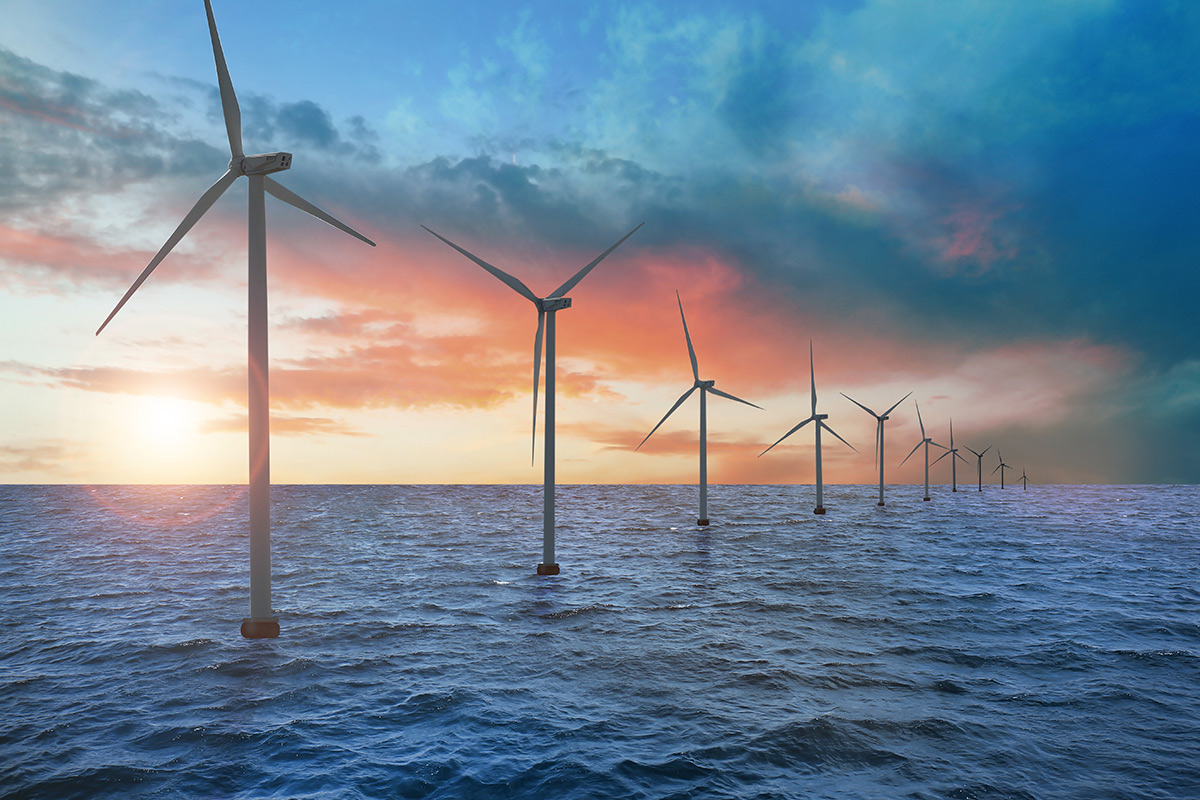The High Cost Of Offshore Wind: Why Energy Firms Are Reconsidering

Table of Contents
Unexpectedly High Capital Expenditure (CAPEX)
The initial investment in offshore wind farms – the CAPEX – has proven far higher than initially projected. This cost escalation stems from several interconnected factors.
Supply Chain Bottlenecks and Inflation
Global supply chain disruptions have severely impacted the offshore wind industry. Material shortages, particularly of steel, concrete, and specialized components like turbines and blades, have driven prices sky-high. Simultaneously, rampant inflation has further exacerbated these cost increases.
- Increased prices of raw materials: Steel prices, for example, have fluctuated wildly, adding significantly to the cost of turbine foundations and supporting structures.
- Delays in equipment delivery: Lead times for crucial components have stretched dramatically, leading to project delays and increased financing costs.
- Labor shortages driving up wages: The skilled labor needed for offshore wind construction is in short supply, pushing up wages and impacting project budgets.
For instance, the Vineyard Wind project off the coast of Massachusetts faced substantial delays and cost overruns due to supply chain bottlenecks affecting the delivery of key components.
Complex Engineering and Installation Challenges
Offshore wind farm construction presents unique engineering challenges, demanding specialized equipment and expertise. The sheer scale and complexity of these projects significantly contribute to their high cost.
- Deep-water installation challenges: Installing turbines in deeper waters requires specialized vessels and techniques, significantly increasing costs.
- Turbine size and weight: The trend towards larger, more powerful turbines increases transportation and installation costs.
- Grid connection difficulties: Connecting offshore wind farms to the onshore electricity grid can be technically challenging and expensive, often requiring extensive subsea cable installations.
The early challenges faced by several European offshore wind projects, where foundation failures led to significant repair costs and project delays, highlight the inherent risks and expense associated with these complex engineering feats.
Elevated Operational Expenditure (OPEX)
The ongoing costs of operating and maintaining offshore wind farms – the OPEX – are also considerably higher than anticipated.
Maintenance and Repair Costs
Maintaining and repairing offshore wind turbines in harsh marine environments is expensive and logistically challenging.
- Accessibility challenges: Reaching turbines located far offshore requires specialized vessels and skilled technicians, increasing maintenance costs.
- Specialized vessels and equipment: Specialized cranes, platforms, and repair vessels are necessary for maintenance and repair operations.
- Corrosion issues: The corrosive marine environment accelerates the deterioration of turbine components, requiring frequent repairs and replacements.
- Extreme weather damage: Offshore wind turbines are vulnerable to extreme weather events, leading to costly repairs and downtime.
For example, the cost of deploying and utilizing specialized maintenance vessels for offshore wind farms can account for a considerable portion of the overall OPEX.
Decommissioning and Environmental Remediation
The end-of-life decommissioning of offshore wind farms presents another significant cost challenge.
- Waste disposal costs: Proper disposal of turbine components and other materials is costly and requires specialized handling.
- Environmental impact assessments: Thorough environmental impact assessments are necessary to ensure the decommissioning process is environmentally sound.
- Specialized decommissioning expertise: Specialized equipment and expertise are required for the safe and efficient dismantling of offshore structures.
The costs associated with decommissioning existing offshore oil and gas platforms serve as a cautionary tale, indicating the substantial expenses likely to be incurred for future offshore wind farm decommissioning.
Permitting and Regulatory Hurdles
Navigating the permitting and regulatory landscape for offshore wind projects is a protracted and expensive process.
Lengthy Permitting Processes
The lengthy permitting process significantly extends project timelines, increasing financing costs and delaying the return on investment.
- Environmental impact assessments: Extensive environmental impact assessments are required, often taking years to complete.
- Stakeholder consultations: Extensive consultations with various stakeholders, including local communities, environmental groups, and government agencies, are necessary.
- Regulatory approvals: Securing all necessary regulatory approvals from multiple agencies at various levels of government can be a time-consuming process.
Numerous projects have experienced significant delays due to protracted permitting processes, resulting in substantial cost overruns.
Changing Regulatory Landscapes
Evolving environmental regulations add complexity and further increase costs.
- Increased scrutiny of environmental impact: Growing concerns about the environmental impact of offshore wind farms lead to more stringent regulatory requirements and increased monitoring costs.
- Changes in grid connection standards: Changes in grid connection standards can necessitate costly modifications to existing infrastructure.
- Potential for legal challenges: Offshore wind projects often face legal challenges from opponents, adding uncertainty and increasing costs.
Changes in environmental regulations have added substantially to the costs of several existing offshore wind projects, demonstrating the dynamic and challenging nature of the regulatory environment.
Financing Challenges and Investor Hesitation
The escalating costs of offshore wind projects have created significant financing challenges and increased investor hesitancy.
Increased Risk Perception
Cost overruns and delays have heightened the perceived risk associated with offshore wind investments.
- Investor reluctance: Investors are becoming increasingly reluctant to commit capital to projects with high uncertainty and potential cost overruns.
- Higher interest rates: The increased risk profile of offshore wind projects often leads to higher interest rates on project financing.
- Difficulty in securing project insurance: Securing adequate insurance coverage for offshore wind projects has become more challenging due to the increased risk profile.
Several projects have struggled to secure funding due to the escalating costs and increased risk perception among investors.
Return on Investment (ROI) Concerns
Rising costs directly impact the overall ROI of offshore wind projects, making them less attractive to investors.
- Longer payback periods: Increased costs translate to longer payback periods, reducing the attractiveness of these investments.
- Reduced profitability margins: Higher costs squeeze profitability margins, potentially making projects less financially viable.
- Increased uncertainty: The uncertainty surrounding future costs and regulatory changes adds to investor hesitation.
Comparing the ROI of offshore wind with other renewable energy sources, such as onshore wind and solar, highlights the relative competitiveness and challenges facing the offshore wind sector.
Conclusion
The high cost of offshore wind energy is a complex issue stemming from a confluence of factors: unexpectedly high CAPEX due to supply chain issues and challenging engineering, elevated OPEX linked to maintenance and decommissioning, lengthy permitting processes, and the resulting financing challenges and investor hesitation. These factors collectively threaten to hinder the growth of this crucial renewable energy source. The implications are significant for the global transition to clean energy, potentially slowing the decarbonization process. Understanding the high cost of offshore wind is critical for the future of clean energy. Let’s work together to find solutions to bring down the cost of offshore wind and accelerate the transition to renewable energy.

Featured Posts
-
 Consultoria De Fred Luz Encerra Parceria Com O Corinthians
May 04, 2025
Consultoria De Fred Luz Encerra Parceria Com O Corinthians
May 04, 2025 -
 Canelo Alvarez Gives Jake Paul Relationship Guidance Following Engagement
May 04, 2025
Canelo Alvarez Gives Jake Paul Relationship Guidance Following Engagement
May 04, 2025 -
 Death Threat Against Nigel Farage Afghan Migrants Alleged Plot During Uk Trip
May 04, 2025
Death Threat Against Nigel Farage Afghan Migrants Alleged Plot During Uk Trip
May 04, 2025 -
 Gibonni Gost Na Sarajevo Sajmu Knjiga Nova Knjiga I Susret S Obozavateljima
May 04, 2025
Gibonni Gost Na Sarajevo Sajmu Knjiga Nova Knjiga I Susret S Obozavateljima
May 04, 2025 -
 Ufc 314 Volkanovski Vs Lopes Fight Card Breakdown
May 04, 2025
Ufc 314 Volkanovski Vs Lopes Fight Card Breakdown
May 04, 2025
